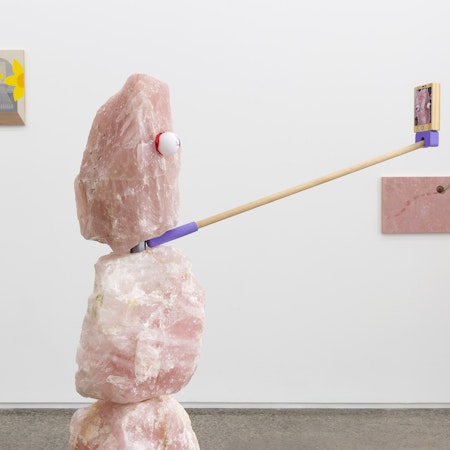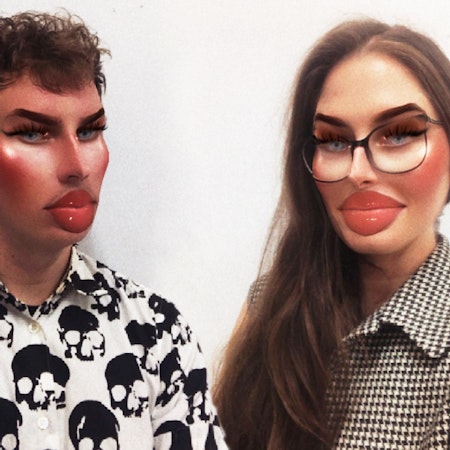Spiritual Poverty by Sarah Brasier and Matthew Harris at Gertrude Glasshouse is an exhibition about lifestyle seen through a tawdry lens. It looks like Deans Art, inspired by their neighbour Gertrude in Preston, decided to expand the franchise to open a contemporary art gallery in partnership with Broadsheet (please don’t). One enters Glasshouse to encounter paintings about anthropomorphic creatures by Sarah Brasier on the walls, resembling op shop rejects, and humanoid sculptures by Mathew Harris on the floor, made with materials such as “Kmart Wooden Work from Home Playset”. They both handle these vernaculars with perversion, to incorporate expressions of earthly vulgarity, such as iguanas spooning in Brasier’s Nang? (2022) and a troubled masturbator in Harris’ Computer Love (2022).
The title of the show, Spiritual Poverty, connotes a state of hollowness that is grounded in these forms. Indeed, both artists trade in cheapness—Brasier invoking the comical authenticity of second hand shops and Harris conjuring the toxic artificiality of malls—to parody states of indulgence. This is a familiar sight in the creative industries once the sun sets, when the self-proclaimed heroes against the forces of neoliberalism suddenly become hobby rat labs: Booboo, I think you need spiritual alignment more than cocaine. This substance becomes a signifier for the paradoxical value of aesthetics manifest in the show, for it is rather expensive (smart call for a bag without ingredients), even though it is culturally cheap. Spiritual Poverty inverts this effect by becoming culturally expensive at the hand of the artists, who elevate the low to the high (*ba da boom tss*). Drugs are the negative of this semiotic reel, the show is the picture.
The first work in the exhibition is in fact Harris’ bronze sculpture Late for Brunch (2022), made with a replica of Alberto Giacometti’s Walking Man (1960), that the artist modified by placing a blonde wig on its head, a handbag on its arm, and cocaine on its nose. The original shows an ugly stick figure taking a step forward with patriarchal universalism, heading to a philosophical destination. Harris’ presents a hilarious campification of Giacometti’s sculpture and its laughable existential angst by invoking the excesses of The Real Housewives of Melbourne. But it also recalls familiar people in the arts, the kind to lose their shit reading this purposely ambiguous sentence (mhmm, so annoying). The figure is positioned to create the illusion of a visitor entering the gallery, dispelling the myth that contemporary art attracts deep people. The title, Late for Brunch, reveals the next stop in this person’s leisurely schedule. It is a mocking view on the romanticism that surrounds the structures of the creative industry, which intends to separate itself from banality but often shares the same demographic as a mid-range shopping mall.
Brasier also features cocaine or ketamine in her acrylic painting If it makes you happy it can’t be that bad (2022), where two butterflies are joyfully snorting lines above a pink flower amidst a yellow background. The colourful image is hysterical, since it looks beautifully conservative from afar, until it reveals mischief upon closer inspection. The idea of representing butterflies sucking nectar conjures uncomfortable moments, such as talking to a host about the painting in their living room, which turns out to be theirs (and now they are monologuing about it). Or forwarding a post about nature to a crush on Instagram, only to find a ‘Seen 7 days ago’ a week later. Rarely, if ever, something good comes out of butterfly images. Brasier connects with this sense of doom, found in supposedly optimistic pictures. The butterfly, previously a symbol of transformation, is now stagnated by the most repetitive, stereotypical and unexciting thing in the world: hope. I mean, party drugs in the arts.

